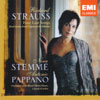Strauss, R Four Last Songs; Salome: Final Scene; Capriccio: Final Scene
From a spooky Salome to fine farewell, Pappano and his star’s superb Strauss
View record and artist detailsRecord and Artist Details
Composer or Director: Richard Strauss
Label: EMI Classics
Magazine Review Date: 6/2007
Media Format: CD or Download
Media Runtime: 56
Mastering:
Stereo
DDD
Catalogue Number: 3787972

Tracks:
| Composition | Artist Credit |
|---|---|
| Salome, Movement: Ach, du wolltest mich nicht deinen Mund küssen lassen |
Richard Strauss, Composer
Antonio Pappano, Conductor Gerhard Siegel, Tenor Liora Grodnikaite, Mezzo soprano Nina Stemme, Soprano Richard Strauss, Composer Royal Opera House Orchestra, Covent Garden |
| Capriccio, Movement: Interlude (moonlight music) |
Richard Strauss, Composer
Antonio Pappano, Conductor Richard Strauss, Composer Royal Opera House Orchestra, Covent Garden |
| Capriccio, Movement: ~ |
Richard Strauss, Composer
Antonio Pappano, Conductor Jeremy White, Bass Nina Stemme, Soprano Richard Strauss, Composer Royal Opera House Orchestra, Covent Garden |
| (4) Letzte Lieder, '(4) Last Songs' |
Richard Strauss, Composer
Antonio Pappano, Conductor Nina Stemme, Soprano Peter Manning, Violin Richard Clews, Horn Richard Strauss, Composer Royal Opera House Orchestra, Covent Garden |
Author: Mike Ashman
To borrow a phrase from Richard Osborne, mighty tents are already pitched on these fields – for the Songs Schwarzkopf/Szell, Della Casa/Böhm, Norman/Masur; for the Salome finale Krauss/Cebotari, Welitsch/Reiner and so on. But the conductor who has already got onto record a newly thought-through Bohème, a Tosca that can hold its own with de Sabata’s, and a modern Tristan with Domingo need fear no competition. All the hounds of hell are let loose by the ROH’s percussion section to launch a wild, but always intricately shaped and detailed, account of young Princess Salome’s sickly Liebestod. Being already a searching, grown-up Isolde, Stemme, like her 1950s forerunners, now really manages to be a teenage Isolde too, by turns sweet, spooky and growing up.
The discs’s running order is cunning and effective, and both conductor and soprano are in command of the switch to Madeleine’s music-or-words dilemma. In Capriccio’s Moonlight Interlude, as in the Songs, Pappano achieves richness without overweighting; his rubato lingers rather than indulges (like…but let’s not compare). Stemme is a more torn and dramatic Countess than, say, Janowitz, Schwarzkopf or Della Casa; this performance harks back to Clemens Krauss and Viorica Ursuleac, emotion shaping the (fine) text, rather than vice-versa
As if to create a valedictory survey of Strauss, the soprano voice and the orchestra, the start of “Frühling” aptly seconds the Countess’s mood. Michael Tanner’s note for the new remastering of Flagstad’s creator’s performance (see above) remarks how tempi in this work have got slower over the past 50 years. Pappano and his orchestra (what solo playing!), while never hurrying, keep the forward pace of an attentive Lied accompanist – emotional points are made without milking, matching the cool beauty of the soloist’s timbre. Stemme has vocal height and weight in equal measure and (again) really uses her text. Finally, the record is produced and engineered with sensitivity to the layout of Strauss’s instrumental and vocal textures.
The discs’s running order is cunning and effective, and both conductor and soprano are in command of the switch to Madeleine’s music-or-words dilemma. In Capriccio’s Moonlight Interlude, as in the Songs, Pappano achieves richness without overweighting; his rubato lingers rather than indulges (like…but let’s not compare). Stemme is a more torn and dramatic Countess than, say, Janowitz, Schwarzkopf or Della Casa; this performance harks back to Clemens Krauss and Viorica Ursuleac, emotion shaping the (fine) text, rather than vice-versa
As if to create a valedictory survey of Strauss, the soprano voice and the orchestra, the start of “Frühling” aptly seconds the Countess’s mood. Michael Tanner’s note for the new remastering of Flagstad’s creator’s performance (see above) remarks how tempi in this work have got slower over the past 50 years. Pappano and his orchestra (what solo playing!), while never hurrying, keep the forward pace of an attentive Lied accompanist – emotional points are made without milking, matching the cool beauty of the soloist’s timbre. Stemme has vocal height and weight in equal measure and (again) really uses her text. Finally, the record is produced and engineered with sensitivity to the layout of Strauss’s instrumental and vocal textures.
Discover the world's largest classical music catalogue with Presto Music.

Gramophone Digital Club
- Digital Edition
- Digital Archive
- Reviews Database
- Full website access
From £8.75 / month
Subscribe
Gramophone Full Club
- Print Edition
- Digital Edition
- Digital Archive
- Reviews Database
- Full website access
From £11.00 / month
Subscribe
If you are a library, university or other organisation that would be interested in an institutional subscription to Gramophone please click here for further information.




